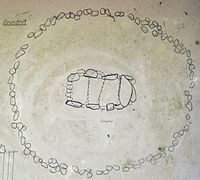Stone grave in oak wood
| Stone grave in oak wood | ||
|---|---|---|
|
The large stone grave Gnarrenburg |
||
|
|
||
| Coordinates | 53 ° 23 '48.7 " N , 8 ° 59' 59.2" E | |
| place | Gnarrenburg , Lower Saxony , Germany | |
| Emergence | 3500 to 2800 BC Chr. | |
The stone grave in Eichholz is a Neolithic megalithic complex . It originated between 3500 and 2800 BC. BC as a plant of the funnel beaker culture (TBK).
location
The stone grave is located north of Gnarrenburg , in the Eichholz state forest, in the Elbe-Weser triangle in a pine forest, not far from the forest road that leads from Gnarrenburg to the Brillit district , in the Rotenburg district in Lower Saxony .
description
Johannes Heinrich Müller and Jacobus Reimers describe the stone grave in "The prehistoric antiquities of the province of Hanover" from (1893) as already considerably damaged. Two other larger stones were later removed. The system examined by Jürgen Deichmüller in 1968 has been restored. Your indefinable being of type chamber ( passage grave or great dolmen ) was surrounded by a sheath of 6500-7000 Rolling Stones, who also covered the deck stones. According to the excavation findings, this stone layer was probably covered with a loamy layer ( SI ) about 0.25 meters thick, which was overgrown with grass or heather . The hill was surrounded by an oval border, atypical for the region, made of stones set on edge with a size of up to 0.70 × 0.40 meters.
The possibly trapezoidal chamber floor plan is difficult to assess due to the irregularities on the northern long side and a missing end stone. The south side of the south-west-north-east oriented chamber, with the supporting stones that remained there, is considerably disturbed along its entire length . The four bearing stones that have been preserved on the north side are very inconsistent in terms of size and material and are partially tilted. A mighty granite block forms the north-eastern end stone of the chamber . The end stone on the southwest side, including the expected shoulder lane, is missing. Instead, there was a rolling stone wall that merged directly into the stone packing of the hill. The complex probably had four cap stones, one of which has been preserved in situ .
The interior of the chamber was disturbed on the south side, in places up to the paving. The rest of the room was filled to about 0.50 meters below the upper edge of the bearing stone with a mixture of loamy sand, larger and smaller rubble , as well as traces of charred wood, flint and broken glass. The topmost, humus-containing layer reached almost everywhere to the top of the bearing stones. She was disturbed and modern. The torso of a cover plate, which today covers the northeastern end of the chamber, was placed during the restoration.
In accordance with the disturbed status, the inventory was in places not in situ . The following groups of finds can be distinguished:
- Ceramic shards and arrowheads of the funnel cup culture ,
- Ceramic shards, arrowheads and flint axes of the individual grave culture
- Urn shards of the Iron Age .
In total, more than 600 sherds were found (524 of them Neolithic ). 456 of these could be assigned to 24 different vessels of the cultures mentioned. 84 remains of Iron Age urn shards and those that could not be culturally classified. As evidenced by the deep engraving ceramics, the stone grave was erected at the turn of the 4th to the 3rd millennium. Occupancy phases by the carriers of the funnel beaker culture must be proven. Afterwards, perhaps even at the same time, representatives of the individual grave culture were buried with gifts of beakers. Whether the urn burials of the older Iron Age took place inside the stone chamber or directly in front of it could not be proven because of the severe disturbance on the south side.
In the northwest, outside the stone wreath, there was a so-called cult niche, an elongated-oval stone semicircle, the opening of which was directed towards a large, flat, almost rectangular stone. A large hill rises about 50 meters to the east, which could also contain a large stone grave. The two monuments are surrounded by a dozen smaller burial mounds.
- Stone grave in oak wood
See also
literature
- Jürgen Deichmüller: The stone grave in the oak wood near Gnarrenburg, Kr. Bremervörde . In: New excavations and research in Lower Saxony 7, 1972, p. 24 ff.
- Johannes Heinrich Müller : Report on antiquities in Hanover. In: Archives of the Association for History and Antiquities in Stade. Volume 4, 1871, pp. 364-365 ( online ).
- Johannes Heinrich Müller, Jacobus Reimers : Pre and early historical antiquities of the province of Hanover. Schulze, Hannover 1893, p. 232 ( PDF; 25.0 MB ).
- Ernst Sprockhoff : Atlas of the megalithic tombs of Germany. Part 3: Lower Saxony - Westphalia. Rudolf-Habelt Verlag, Bonn 1975, ISBN 3-7749-1326-9 , p. 19.





